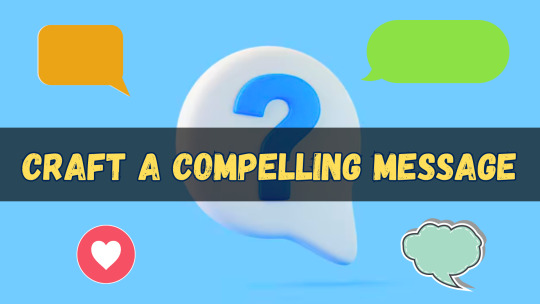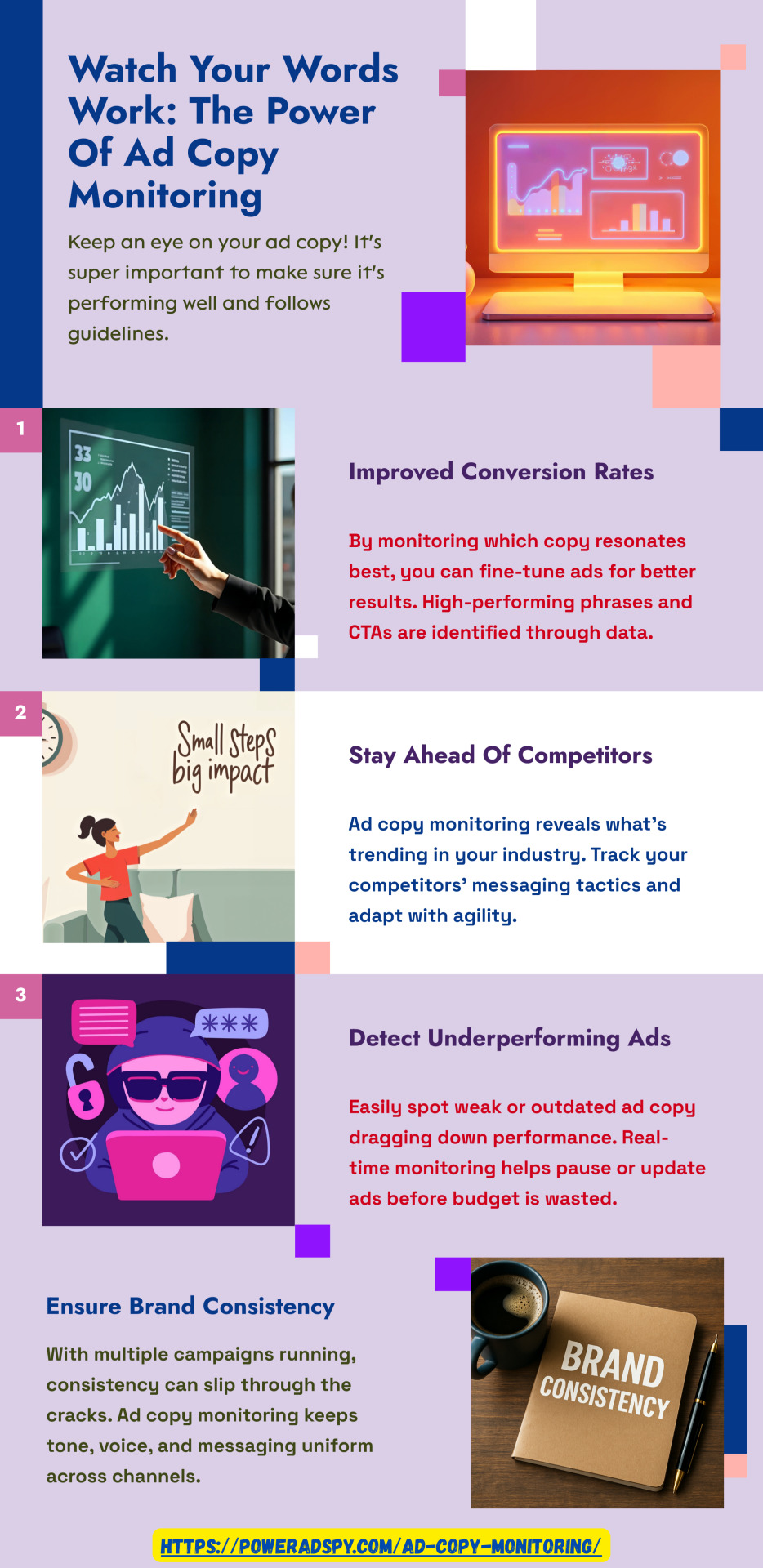#Ad Copy
Explore tagged Tumblr posts
Text
#digital marketing#advertising#website#marketing strategies#seo services#smm services#google ads#emailmarketing#search engine optimization#social media marketing#content marketing#ad copy
3 notes
·
View notes
Text
Ad Creation Made Easy: Step-by-Step Guide for Beginners

Creating ads may seem overwhelming if you're just starting, but with the right approach and tools, ad creation can become an accessible and effective way to reach your audience, drive traffic, and boost conversions. Whether you're a business owner, content creator, or marketer, understanding the basics of ad creation is crucial to maximizing your digital marketing efforts. This step-by-step guide will walk you through the essentials of ad creation, making it easy for beginners to craft compelling, results-driven ads.
Step 1: Understand Your Audience
Before you create an ad, it’s crucial to understand who you’re targeting. Knowing your audience helps you design more relevant and compelling ads that will resonate with users. Consider the following factors:
Demographics: Age, gender, location, and income level can influence how your ad is perceived.
Interests: What are your audience's hobbies, preferences, and behaviors?
Step 2: Define Your Goal

What is the goal you want to achieve with your advertisement? Clearly defining your objective is vital for successful ad creation, including keyword-based ad campaigns. Your goal might fall into one of the following categories:
Brand Awareness: Let people know about your product, service, or content.
Lead Generation: Capture contact information from potential customers.
Step 3: Choose the Right Ad Format
Different platforms have different ad formats that may work better depending on your goal. Here are a few popular platforms and the ad formats you can use:
Facebook & Instagram Ads: These platforms allow a variety of ad types, including image ads, carousel ads (multiple images or videos), video ads, and story ads. They’re great for visual content and social engagement.
Step 4: Craft a Compelling Message

The content of your ad—its copy and visuals—plays a significant role in its success. Here are some suggestions for creating impactful ad copy:
Keep It Simple: People have limited attention spans, so make sure your ad is concise and to the point. Focus on delivering a message quickly and clearly.
Highlight the Benefits: Explain how your product or service solves a problem or meets a need. Use language that appeals to your audience's desires or pain points.
Step 5: Design Your Visual Elements
A visually appealing ad will draw attention and increase the likelihood that users will click or engage. Consider these design tips:
Keep It Simple:Avoid cluttering your ad with excessive text or images. Instead, concentrate on delivering a single, clear message or offer.
Brand Consistency: Use your brand’s colors, logo, and fonts to maintain consistency across all your ads.
Step 6: Optimize Your Ad for Performance

Once your ad is live, it’s important to track its performance and make necessary adjustments. Important metrics to track include:
Click-through Rate (CTR):The proportion of individuals who clicked on your ad after viewing it. A higher CTR signifies that the ad is performing well.
Conversion Rate: The percentage of users who took the desired action (e.g., made a purchase, signed up) after clicking your ad.
Step 7: Test and Iterate
Ongoing testing and optimization are essential for achieving success in ad creation. A/B testing (comparing two versions of an ad) can help you determine what resonates best with your audience. Test different elements like:
Headlines
Call-to-Action
Images and Video Thumbnails
You can also watch: Effortless & Smart Ad Creation Made Simple with AdsGPT!
youtube
Conclusion
Ad creation doesn’t have to be a complicated process. By following these simple steps—understanding your audience, setting clear objectives, selecting the right platform and format, crafting compelling ad copy, and optimizing based on performance—you can do ad creation that effectively engage your audience and meet your marketing goals. Remember, successful ads are the result of constant testing and refinement, so don’t be afraid to experiment and learn as you go.
3 notes
·
View notes
Text

Tips for Effective Ad Creation
In this Infographics, you will get to know about the tips for effective ad creation.
2 notes
·
View notes
Text
How to Structure Your Google Ads Campaign for Better ROI

If you’re looking to maximize the return on investment (ROI) from your Google Ads campaigns, structuring your campaigns effectively is crucial. A well-organized campaign ensures that your ads reach the right audience, minimize wasteful spending, and deliver measurable results. In this guide, we’ll outline the key steps to structure your Google Ads campaign for better ROI.
Also, for a deep understanding, consider reading the blog: The definitive guide on maximizing ROI with Google ads.
1. Define Clear Goals and Objectives
Before diving into campaign setup, establish clear goals for what you want to achieve. Are you focusing on brand awareness, lead generation, or eCommerce sales? Defining your objectives helps you:
Choose the right campaign type (e.g., Search, Display, Shopping, or Video).
Set measurable KPIs like cost-per-click (CPC), conversion rate, or return on ad spend (ROAS).
2. Conduct Comprehensive Keyword Research
Keywords form the foundation of any Google Ads campaign. Use tools like Google’s Keyword Planner or SEMrush to identify relevant keywords that align with your goals. Segment these keywords into:
High-intent keywords (e.g., “buy running shoes” for sales campaigns).
Informational keywords for awareness campaigns.
Group your keywords logically to make ad groups tightly focused, which improves your Quality Score and ad relevance.
3. Create Well-Structured Campaigns and Ad Groups
Organizing your campaigns and ad groups is critical for precise targeting and budget allocation. Follow these principles:
Campaign-Level Structure: Organize campaigns by objectives, product categories, or services.
Ad Group-Level Structure: Group related keywords and tailor your ads for each group.
For example, if you’re advertising running shoes, create separate ad groups for men’s, women’s, and kids’ running shoes.
4. Optimize Your Ad Copy and Assets
Your ads should be compelling, clear, and relevant to the audience’s intent. Incorporate the following best practices:
Use action-oriented language (e.g., “Shop Now,” “Get a Free Quote”).
Highlight your unique selling propositions (USPs).
Include keywords from your ad group in the ad copy.
Leverage ad extensions like sitelinks, callouts, and structured snippets to provide additional information and improve click-through rates (CTR).
5. Leverage Audience Targeting
Audience targeting refines your reach to users most likely to convert. Use Google’s audience options to target:
Affinity Audiences: Broader audiences based on interests and habits.
In-Market Audiences: Users actively searching for products or services.
Remarketing Lists: Re-engage past visitors who showed interest in your offerings.
6. Monitor and Optimize Bidding Strategies
Choosing the right bidding strategy significantly impacts ROI. Popular options include:
Manual CPC for precise control.
Target ROAS for automated ROI-focused bidding.
Maximize Conversions to drive volume while staying within your budget.
Continuously analyze performance and adjust bids based on data.
7. Refine Landing Pages
A high-quality landing page is essential for converting ad clicks into actions. Ensure that your landing pages:
Are highly relevant to the ad copy.
Load quickly and are mobile-friendly.
Feature clear calls-to-action (CTAs) and minimal distractions.
Pro Tip: Conduct A/B testing to find the most effective designs and CTAs.
8. Regularly Analyze and Optimize Campaign Performance
Ongoing optimization is the key to better ROI. Use Google Ads reports to:
Identify high-performing and underperforming keywords.
Adjust budget allocations to prioritize successful campaigns.
Experiment with new ad creatives and targeting options.
Conclusion
Effectively structuring your Google Ads campaign is the foundation for achieving better ROI. By defining clear goals, organizing campaigns logically, refining ad copy, and leveraging audience targeting, you can create campaigns that consistently perform. Don’t forget to regularly analyze and optimize your strategies to stay ahead of the competition.
For expert assistance with Google Ads management, consider reaching out to Forerunner Marketing’s Google Advertising Services. Their team specializes in helping businesses maximize their advertising potential through tailored strategies and continuous optimization.
#Google Ads#Google Ads Campaign#ROI#Digital Advertising#Keyword Research#Ad Copy#Campaign Optimization#Audience Targeting#PPC#Pay-Per-Click Advertising#Bidding Strategies#Landing Page Optimization#Google Ads Management#Online Marketing#Conversion Rate Optimization
2 notes
·
View notes
Text
Nobody reads advertising. People read what interests them, and sometimes it's an ad.
— Howard Luck Gossage, advertising iconoclast
#quotes#copywriting#mad men#advertising#marketing#ad copy#professional writing#copy editing#writers on writing
8 notes
·
View notes
Text

Do's and Don'ts for Google Ads Success: 👍DO: Research keywords thoroughly 👍DO: Create compelling ad copy 👍 DO: Set a clear budget and goals 👍 DO: Monitor and optimize regularly 👍 DO: Use ad extensions wisely
🚫 DON'T: Neglect negative keywords 🚫 DON'T: Ignore landing page quality 🚫 DON'T: Overlook mobile optimization 🚫 DON'T: Run ads without A/B testing 🚫 DON'T: Forget to track conversions
For more such tips, follow @dreamerzmindz
#dreamerzmindz#Google ads#Paid ads#Keyword research#Landing Page#Mobile Optimzation#Track conversions#Instant Result#Ad Copy#Budget Management#ROI#click through rate#Ad Extension#Digital Marketing#Online Advertising#googleads#paidads#keywordresearch#landingpage#mobileoptimization#trackconversions#instantresult#AdCopy#BudgetManagement#ClickThroughRate#AdExtensions#PPCAdvertising#DigitalMarketing#OnlineAdvertising#AdWords
3 notes
·
View notes
Text
I'm using Backblaze for in-cloud full backup, as well as a non-cloud external hard drive for the same purpose.
Active writing files, besides inclusion in the full backups, also save to Dropbox, to relevant folders on the PC's hard drive and to an offline USB thumb drive.
As for writing software, I have Scrivener, Fade In and Word 2010 (LibreOffice will replace it if / when need be) along with ProWritingAid, Dragon Naturally Speaking and a computer microphone or recorder.

And now a word from our sponsor.
*****
Voice-to-Text is associated with Handwriting™, one of the oldest and perhaps the best-known word-processing app.
Handwriting™ uses the most widely available OS on the planet.
Handwriting™ can be customised or upgraded with a range of input devices (not included), fonts, colours and even languages, and accepts all off-brand ink and paper consumables with no need for DRM compatibility.
Handwriting™ is environmentally green, has no unusual energy requirements, needs no battery or external power source, and is in most respects almost completely biodegradable.* This also applies to the default OS, a claim few word-processing apps can match.
* For longer-lasting or archive purposes, try Monument™ or Cuneiform™. Please note that input devices and consumables for these apps differ from Handwriting™ in some respects, and may require additional training prior to use.
Handwriting™ is virtually crash-proof apart from exceptional circumstances, and is impossible to modify, hack or censor without direct physical access.
Handwriting™ has not just years or decades but centuries of proven reliability, with millions of satisfied users.
Try Handwriting™, and rediscover how to write in dark places when all other Rights go out.
Amount of light required for successful operation in dark places varies with user, and may be augmented by a range of third-party devices (not included).
Clarity of input varies with user, and may improve.
Quality of output varies with user, and may improve.
Clarity and quality may go down as well as up.
Input language varies with user, and additional languages (not included) may be used at any time or added later, but refer to 4. for more details.
Keep product away from naked flame.
Keep user away from naked flame. Distance varies with ambient temperature, but do not exceed default OS limits.
Do not immerse product in water.
Do not immerse user in deep water. Depth varies with ambient temperature, but do not exceed default OS limits.
Conditions of excessive damp or humidity require modified input devices and consumables, available from specialised dealers.
Use of Handwriting™ implies understanding and acceptance of all terms and conditions.
Handwriting™ has no control over (and accepts no responsibility for the consequences of) views, opinions, comments, truths, lies, propaganda, fiction, myth, religion, controversy, entertainment, historical records, political complications, economic errors, romantic entanglements and / or warm fuzzies generated by use of the product.
dang LOOK its chuck tingle talkin to wired magazine about the danger of technology functioning as unchecked corporate utilities. was nice to give this little quote. good article
5K notes
·
View notes
Text

The pills meme but it's things i wish i had
#i think out of all of these i would probably pick purple and pink though#my posts#someone in the rbs added an image desc so i copy pasted that
34K notes
·
View notes
Text
What Is Ad Copy and How Do You Write It Effectively?

Ever wondered why some ads grab your attention instantly while others fall flat?
The answer often lies in the written message, the content designed to persuade, engage, and drive action. Whether you're crafting a Google ad, a Facebook campaign, or a billboard slogan, compelling promotional text can make the difference between a scroll past and a sale. This article breaks down exactly what this kind of messaging is, why it matters, and how to write it so your audience pays attention and takes action.
What Is Promotional Text in Advertising?
Ad copy or promotional text is the compelling written content crafted for advertising purposes, aimed at promoting a product, service, or idea. Its primary goal is to ignite interest and persuade readers to take a desired action, whether it's clicking a link, making a purchase, or subscribing to a newsletter. Through engaging language and persuasive techniques, effective marketing messages captivate the audience, drawing them closer to the brand and motivating them to engage further.
Why Is It So Important?
This messaging serves as your brand’s voice in a competitive digital landscape. Strong advertising content not only increases conversions but also builds trust and brand recognition.
How to Write Effective Advertising Content (Step-by-Step)
1. Know Your Audience

The most successful messaging speaks directly to the reader’s needs and pain points. Ask yourself:
Who are you talking to?
What do they care about?
What language do they use?
2. Lead With a Hook
You have 1–2 seconds to stop someone from scrolling, so a hook is essential.
Examples of strong hooks include:
“Tired of overpaying for car insurance?”
“Stop wasting time on diets that don’t work.”
“Unlock 3x faster results without extra effort.”
Use curiosity, pain points, or bold promises without being misleading.
3. Focus on Benefits, Not Features
Features tell; benefits sell.
Rather than merely cataloging the functionalities of your product, delve into how it enhances the user's experience and meets their needs. Focus on the transformations your product facilitates in their lives, illustrating the value and satisfaction they will gain from using it.
4. Add Social Proof or Credibility
People trust other people, especially when deciding whether to buy. Consider adding:
Customer reviews
Testimonials
Certifications or awards
Numbers (e.g., “Over 10,000 happy users”)
5. Include a Strong Call to Action (CTA)
Don’t assume your reader knows what to do next.
Effective CTAs include:
“Get started now”
"Try it free today"
"Download your free guide"
Make it action-driven and urgent, but not pushy.
6. Test and Refine Constantly
Even the best writers don’t get it perfect on the first try.
Test variations of:
Headlines

CTAs
Tone or length
Visual pairings (for social ads)
Use A/B testing tools to see what performs best and optimize accordingly.
Where Is This Messaging Used?
Ad copy appears in a variety of platforms and mediums, serving as a powerful tool for communication and persuasion. It is commonly used in print advertisements such as magazines and newspapers, where catchy headlines and concise messages draw the reader's attention.
Additionally, it plays a prominent role in digital marketing, featured in online ads, social media posts, and email campaigns where it seeks to engage audiences and drive action.
Television and radio commercials also rely heavily on impactful wording to convey messages quickly and effectively, utilizing a combination of visuals and audio to create memorable impressions. Beyond traditional advertising, persuasive text is essential in product packaging and point-of-sale displays, where enticing descriptions and slogans entice consumers at the moment of decision.
This type of messaging appears in virtually every marketing channel, including:
Google Ads (search & display)
Facebook, Instagram, TikTok Ads
Landing pages
Email campaigns

YouTube video ads
Print and billboard ads
Using Keywords Strategically
When writing or optimizing promotional material, it's important to naturally include keywords for search visibility. However, overstuffing can hurt readability and trust. Aim to use the keyword in:
The page’s meta title or description
A headline or subhead
Naturally, in the body, no more than 1–2 times
You can also watch: Globussoft | People @Globussoft
youtube
Summary: Key Takeaways
Ad copy content serves as a compelling narrative in advertising, meticulously crafted to inspire action and engagement. Exceptional messaging is deeply rooted in the needs and desires of the customer, highlighting clear benefits while resonating on an emotional level. To achieve the most effective results, continually test and refine your approach; your audience will provide invaluable insights into what resonates and drives them to act.
FAQ: Common Questions
What’s the difference between advertising text and content writing?
Advertising text is short-form and persuasive, designed for conversions. Content writing is longer-form, informative, and designed for engagement or education.
How long should promotional content be?
It depends on the platform. Google Ads favor brevity, while landing pages allow for more in-depth storytelling. As a rule of thumb, keep it as short as possible but as long as necessary.
What tools help with writing effective messaging?
Grammarly (for clarity and tone)
ChatGPT or Jasper (for ideation)
Google Ads Preview Tool
A/B testing tools like Optimizely
Can AI write persuasive marketing content?
Yes, it can, but human insight remains crucial. AI can assist in generating ideas and drafts, but emotional resonance and brand nuance are derived from real marketers.
1 note
·
View note
Text
In this podcast you will get to know about how can an Instagram ad maker boost your business.
0 notes
Text
How Can an Instagram Ad Maker Boost Your Business?

Getting noticed on Instagram isn’t easy anymore, every brand is fighting for a moment of attention. With over 2 billion users scrolling, tapping, and swiping daily, the pressure to stand out is real.
Today, Instagram remains one of the most powerful platforms for visibility and engagement. But to rise above the noise, businesses need more than just good content, they need smart tools and automation that make creativity faster, sharper, and more effective.
One such tool that’s transforming how businesses approach Instagram marketing is an Instagram ad maker. Designed with features that prioritize speed, customization, and high-quality output, it empowers brands to scale their campaigns quickly, produce eye-catching content, and connect with their audience more effectively than ever before.
Why Instagram Ads Are Crucial for Growth
Before exploring the benefits of automated ad design, it’s important to understand Instagram ads' unique power. With immersive visual formats like Stories, Reels, and carousels, businesses can engage audiences more effectively than on many other platforms.
Instagram offers robust targeting options, allowing businesses to zero in on the right demographic based on interests, behaviors, location, and more. With such flexibility, brands can create highly personalized campaigns that connect deeply with their ideal audience.
However, running impactful campaigns consistently requires creative efficiency, something tough to maintain without the right tools.
The Power of Automation in Ad Design
Manual ad creation can be time-consuming. Between brainstorming ideas, designing visuals, and writing persuasive copy, marketers can quickly find themselves overwhelmed. This is where an advanced ad maker streamlines the entire process.
By automating routine creative tasks, these tools enable teams to work faster while still maintaining high-quality output. Pre-designed templates, drag-and-drop editors, and branding presets simplify design while ensuring consistency across all campaigns.
Even for businesses with limited design experience, modern ad creation tools make it possible to produce professional-grade content that converts.
Ad Copy that Converts: The Role of Generative Tools

The success of a campaign doesn’t just rely on visuals, what your ad says is just as important. That’s where an ad copy generator becomes invaluable.
Instead of spending hours writing and refining headlines or captions, marketers can use AI content creation tools to generate compelling ad copy based on their campaign goals. Whether the focus is brand awareness, lead generation, or product promotion, copy generators suggest language that resonates with your audience.
These tools improve messaging accuracy and conversion rates by leveraging machine learning and data-driven suggestions, saving valuable time.
Consistency Across Campaigns
Consistency in branding builds trust. Using the same visual tone, typography, and messaging style in every piece of content strengthens brand recall. But manually maintaining that consistency across dozens or hundreds of ads is a big challenge.
With an advanced creative platform, businesses can store brand assets, define voice and tone parameters, and apply them automatically to new ads. This ensures every campaign feels aligned, even when created by different team members or across various campaigns.
This uniformity builds recognition and ultimately, long-term loyalty.
What Makes Creative Efficiency a Game-Changer for Instagram Campaigns?
One of the most overlooked challenges in Instagram marketing is the time it takes to go from concept to launch. A successful campaign is differentiated from a mediocre one by its creative efficiency, and the ability to produce high-quality content quickly and at scale. Smart design and automation tools can help businesses reduce production time, maintain brand consistency, and respond to trends faster. This edge not only improves ad performance but also helps maximize return on investment in a highly competitive space.
Collaboration Made Easy

A campaign usually involves several stakeholders, including designers, copywriters, media buyers, and marketing managers. Without a central platform, collaboration can become chaotic.
Ad creation platforms often include features like shared dashboards, comment threads, and task assignments. Paired with an intelligent ad generator, the entire workflow becomes even smoother. This not only improves communication but also accelerates production cycles. Changes are tracked, feedback is centralized, and approvals become more transparent.
When teams work better together, campaigns launch faster and with fewer revisions.
Scaling Made Simple
For businesses looking to scale quickly, efficiency is everything. Launching multiple campaigns across different markets, languages, and customer segments demands a high level of creative productivity.
Rather than recreating each asset from scratch, automation tools allow for bulk editing, asset duplication, and template reuse. This makes it easier to scale campaigns without sacrificing quality or personalization.
An integrated asset library and performance tracking allow businesses to identify and replicate high-performing ads for new audiences.
You can also match:How To Create High-Converting AI Tools Ads with AdsGPT?
youtube
Final Thoughts
Standing out on Instagram isn’t about luck, it’s about speed, creativity, and consistency. With so much visual content competing for attention, businesses have a small window to make a strong impression. Tools that handle design and copywriting behind the scenes make that job easier. They boost efficiency without sacrificing quality, helping brands create campaigns that connect and convert.
Whether you’re a small business owner or part of a large marketing team, embracing smart creative technology can be the key to unlocking Instagram’s full potential. With the right Instagram ad maker, businesses can streamline creative workflows, improve collaboration, and generate content that truly resonates with their audience. When combined with an intelligent ad copy generator, the process becomes even more powerful, ensuring every campaign is not only visually appealing but also strategically aligned.
0 notes
Text

Is Your Ad Copy Driving Unstoppable Gworth?
In This Infographic you will get to know about Ad Copy
To Know more click on :- https://poweradspy.com/ad-copy-writing/
0 notes
Text
Ad Copy Monitoring: The Silent Architect Behind High-Impact Campaigns

In the ever-evolving ecosystem of digital marketing, where attention spans are shrinking and content battles for visibility in milliseconds, ad copy is more than just words—it's your brand's voice, persona, and promise encapsulated in seconds. However, crafting compelling copy is merely the first step; the true art lies in its continuous evaluation. Welcome to the intellectual realm of ad copy monitoring a domain where strategic oversight transforms fleeting impressions into measurable impact.
Every brand aspires to captivate, but few sustain that allure. This is not due to creative inadequacy but often because their campaigns lack a feedback mechanism to refine their narrative dynamically. Monitoring ad copy doesn’t just preserve brand integrity—it evolves it.
Understanding the Essence of Monitoring Ad Copy
At its core, ad monitoring is the systematic analysis of written promotional content to evaluate performance, relevance, and resonance. It is the practice of dissecting how each phrase performs across platforms, demographics, and time frames. It’s not a one-time audit but a persistent pulse check that determines whether your message continues to spark action.
When ad fatigue sets in or messaging fails to align with audience sentiment, campaigns hemorrhage efficacy. Monitoring ensures that the voice of the brand remains both persuasive and contextually relevant.
Key Features of the Monitoring Software
The potency of this process hinges on the software that powers it. Robust ad monitoring platforms are built with intelligence and adaptability at their core. They don’t just collect metrics—they interpret intent and pattern.
Real-Time Sentiment Analysis: The software doesn’t wait for monthly reports. It captures audience reaction in real-time, categorizing responses by tone and intent.
Cross-Platform Integration: Whether it's search engine marketing, social media, or display ads, the tool consolidates data into a single, comparative framework.

Contextual Tagging: Keywords, emotions, call-to-action variations—every nuance of the copy is tagged and tracked for ad performance.
Dynamic Heat Mapping: Visual cues highlight which parts of the ad copy are receiving the most attention, allowing precision in revisions.
Predictive Copy Analytics: Powered by natural language processing, the software suggests probable outcomes of alternate copy formats before deployment.
This technological sophistication transforms reactive correction into proactive optimization—positioning the software as a strategic linchpin rather than a passive utility.
Technical Specifications That Set It Apart

Underneath its sleek dashboard lies a matrix of high-performance architecture. The tool operates on a cloud-native framework, ensuring accessibility across geographies without latency. It supports API integrations with major ad platforms, enabling seamless data ingestion.
Its analytics engine is bolstered by machine learning algorithms trained on thousands of ad variations, equipping the system with predictive accuracy. Additionally, the software is GDPR and CCPA-compliant, embedding ethical intelligence into its design—an often overlooked but crucial specification in today’s data-sensitive climate.
Strategic Importance in a Cluttered Marketplace

Why does this level of scrutiny matter?
Because every scroll, swipe, and pause is a decision point. In this saturated attention economy, clarity is the new persuasion. Ad monitoring ensures that clarity is not lost in creative excess. It elevates performance from coincidence to consistency.
Identifying declining ad engagement trends enables brands to rejuvenate copy before decay sets in. By spotlighting high-performing segments, it informs scalable replication. It aligns messaging with shifting consumer psyche—transforming every campaign from a gamble to a guided experiment.
In essence, it replaces guesswork with granular insight.
Cultural Impact: A Language of Precision
More than just improving metrics, ad monitoring reshapes internal workflows. Teams transition from being content factories to becoming content scientists. Ideation becomes data-informed; revisions become purpose-driven.
Regular reports foster transparency across departments, aligning creative aspirations with analytical clarity. The template of experimentation becomes embedded in the culture, making brands more agile, more reflective, and more in tune with their audience.
It encourages a philosophical shift—from speaking to the audience to listening through the data.
You can also watch: PowerAdSpy - Best Facebook Ads Spy Tool - FREE Beta Access.
youtube
Conclusion: The Unsung Hero of Messaging Excellence
While creative genius ignites a campaign, it is consistency and refinement that fuel longevity. Ad copy monitoring is the silent architect behind that endurance. It doesn’t just fine-tune copy—it fine-tunes connection. In a world where perception is reality, ensuring that your message not only lands but lingers is imperative.
By embracing this discipline, brands don’t just stay visible—they stay valuable.
0 notes
Text

Watch Your Words Work : The Power Of Ad Copy Monitoring
In This Infographic You will Get To Know About Ad Copy Monitoring To Know More Click On :- https://poweradspy.com/ad-copy-monitoring/
0 notes
Text

I've been tinkering with Canva to see what I can do with it and learn something about it's range.
This one is a magazine lay out. I made it out of magazine cut outs and then scanned the page back into Canva.
The words are an imitation of David Wagoner's Lost.
#canva#tinker#collage#scan#photography#ad#advertising#ad copy#copy writing#copy#copywriting#lettering#photoshop#graphic design#layout
0 notes
Text
The Impact of Strong Ad Copy on Brand Image

A well-crafted message has the potential to shape perceptions, captivate audiences, and drive consumer loyalty. When executed effectively, ad messaging is more than just persuasive words—it becomes a strategic tool that reflects a brand’s identity, values, and promises. With every campaign, businesses have the opportunity to leave a lasting impression, influencing how they are perceived in the crowded marketplace.
This blog explores how powerful ad messaging can elevate brand image, creating connections that resonate with audiences across platforms.
The Role of Ad Copy in Shaping Perceptions
A company's brand image is essential to how its audience perceives it. It encompasses the emotional and intellectual associations people make with a brand. Effective communication is essential to creating this impression, and ad copy is the cornerstone of this endeavor. A compelling advertisement doesn't just sell a product; it conveys a story, evokes emotions, and aligns with the audience's values.
Effective advertising communications use clear, concise, and relatable language. They use the power of words to bridge the gap between a brand and its target audience. Whether it’s a witty tagline or an inspiring call to action, the right phrasing can transform an ordinary advertisement into a memorable experience. This is especially crucial in the digital age, where consumers are bombarded with messages every second. A well-crafted ad messaging cuts through the noise and ensures that the brand’s voice stands out.
Building Emotional Connections

A crucial element of successful advertising is the ability to forge emotional connections. For instance, advertisements that highlight personal success stories, community impact, or relatable challenges tend to resonate more. When people feel emotionally invested in a brand, they are more likely to engage with it and share their positive experiences with others.
Strong ad messaging goes beyond transactional appeals and delves into the aspirations, fears, and desires of its audience. For instance, a fitness brand might craft a campaign around personal empowerment and transformation rather than simply focusing on the features of its products. By doing so, the brand positions itself as an ally in the consumer’s journey, strengthening its image in the process.
Consistency Across Channels

A cohesive voice across various platforms—social media, email campaigns, TV commercials, and print—ensures that the audience perceives the brand as reliable and unified. Inconsistent messaging, on the other hand, might mislead customers and dilute a brand's image.
Consistency also involves aligning the tone and language of ad copy with the brand’s overall persona. For example, a luxury brand’s advertisements should exude elegance and sophistication, while a tech startup might adopt a more playful and innovative tone. This alignment reinforces the brand’s position in the market and ensures that every interaction with the audience contributes positively to its image.
The Role of Data and Feedback

Businesses can customize their messaging to target particular needs and interests by examining customer behavior, preferences, and feedback. A/B testing is a powerful method to determine which version of ad copy resonates most with the audience.
Additionally, monitoring engagement metrics such as click-through rates, conversions, and social media interactions provides valuable insights into the effectiveness of advertising efforts. By refining their messaging based on these insights, brands can continuously improve their campaigns and strengthen their image.
Also, watch this video - Meet AdsGPT’s Addie | Smarter Ad Copy Creation In Seconds
youtube
Wrapping Up
A strong brand image is built on top of a strong advertising copy. It shapes perceptions, builds emotional connections, and establishes a consistent voice across platforms. By aligning messaging with the values and aspirations of the target audience, businesses can create a lasting impression that resonates deeply. In today’s competitive marketplace, where every word matters, leveraging impactful ad copy can elevate a brand’s reputation and foster loyalty. With the right approach, businesses can ensure that their voice not only stands out but also defines how they are remembered.
1 note
·
View note